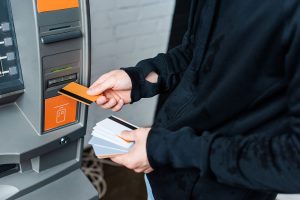How To Protect Against ATM Fraud

In 2006, a man reprogrammed an ATM to make it dispense $20 bills instead of $5 bills. He got the instruction manual online. Eight years later, most ATMs were no longer dispensing $5 bills, but manuals were still online, and two 14-year-old Canadians hacked an ATM in Winnipeg.
Now, it’s 2018, and a quick Google search yields a host of ATM manuals. Hackers (and even kids) know this information is online. With the information so freely available, you may wonder how to protect yourself. Check out these tips:
1. Change Your Passwords
In both of the above situations, the hackers were able to get into the ATMs using default passwords. When you get an ATM, make sure to change the passwords. Never use the default codes. Regardless of the type or brand of ATM you have, there’s a high probability that its default passwords are online.
2. Use Double Factor Authentication
If possible, always use ATMs with double-factor authentication. This requires users to complete two separate steps if they want to change any important elements in how the ATM works. For instance, users may have to enter a password as well as a single-use code that’s texted or emailed to them.
3. Make Sure Your ATM Is Set Up Correctly
When you put in your ATMs, make sure that you have a quality, trustworthy professional handle the installation. They can guide you through the process of setting up passwords, and they can ensure that the installation is done correctly from a security standpoint.
4. Monitor All Updates and Changes
If possible, you may want to set up your ATMs so that you get notifications of any and all changes. This should include routine maintenance, adding cash to the machine, and taking out deposits, but you should also get alerts if changes are made to the surcharge fees or the greeting issued by the machine.
Both of these elements were changed by the Canadian teens mentioned above. Luckily, however, these honest kids changed the greeting to “Don’t use this ATM. It’s been hacked.” Most hackers aren’t so polite.
5. Update Your System Regularly
In a lot of cases, the manuals online are old, but their information is still relevant because many financial institutions forget to keep their ATMs updated. Make sure that you are getting software updates for your ATM on a regular basis.
6. Consider Hiring White Hat Hackers
White hat hackers use their skills for good. In fact, the Winnipeg hackers would be considered white hat because they alerted the bank as soon as they found the weaknesses. They didn’t actually steal any money.
Luckily, you don’t have to wait for random teens to get into your system. You can simply hire some white hat hackers to find any vulnerabilities. Then, you can adjust your protection strategies accordingly.
7. Do Regular Manual Checks
You should also try to service your machines on a regular basis, and you shouldn’t just trust the tallies or balances generated by the ATM. Rather, you should manually count the money in the machine. In the first scam detailed above, the bank could have easily spotted the discrepancy just by comparing the cash in the machine to the electronic records of what had been removed. Then, they could have taken the machine offline until they figured out a solution.
In addition to the above tips, you should let us help. At SQN Banking Systems, we make fraud protection easy. Contact us today to learn more.
